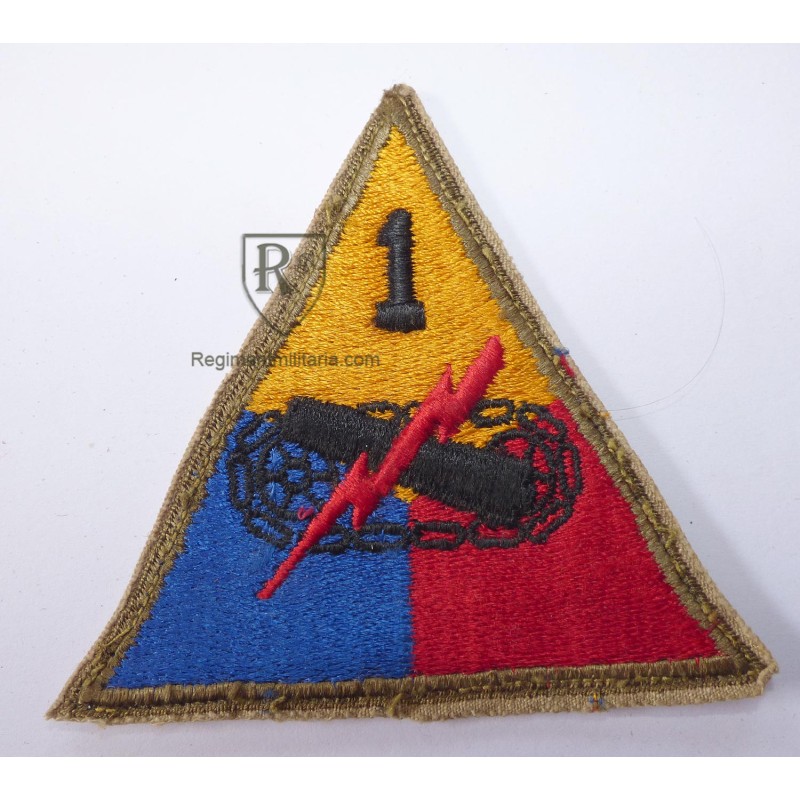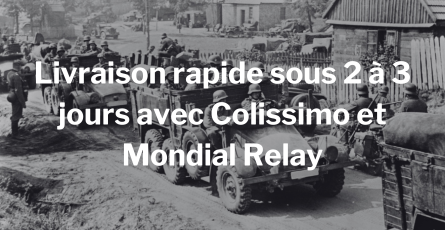
Reference: F2E492
Banner

Banner

Reference: F2E492
Reference: F1E550



 Garanties sécurité
Garanties sécurité
(à modifier dans le module "Réassurance")
 Politique de livraison
Politique de livraison
(à modifier dans le module "Réassurance")
 Politique retours
Politique retours
(à modifier dans le module "Réassurance")
Genuine WWII era shoulder sleeve insignia of the 1st Armored Division.
From late 1943 to early 1944, the division trained in the mountains of Tennessee and was then sent to Fort Bragg, North Carolina for further training. While at Fort Bragg, Technical Sergeant Walter L. Bull earned the first Expert Infantryman Badge. in the Vosges Mountains on 1 November 1944. The division as a whole began the relief of the 45th Infantry Division at Baccarat on 5 November, and took control of the sector on 9 November. The attack broke out on 12 November, and the division entered the German winter line in the Vosges Mountains. The 100th took Bertrichamps and Clairupt, broke through the German line, and captured Raon-l'Étape and Saint-Blaise-Moyenmoutier between 16 and 26 November. Later in November, the division moved into the Vosges Mountains, elements of which helped hold the Saverne Gap bridgehead while the bulk of the division went into reserve. The unit was relieved from its assignment to VI Corps and transferred to the US XV Corps on 27 November 1944. It then moved to the Moselle region.
The Citadel of Bitche, France
In December 1944, the division went on the offensive in the vicinity of Bitche, France. The division occupied the nearby areas of Wingen and Lemberg after heavy fighting on 6 and 10 December. The division then advanced to Reyersviller, which fell after fighting on 11 and 13 December. On 14 December, regiments of the 100th assaulted a small fortification, Freundenburg, and Fort Schiesseck, a major defensive work in the area. Fort Freundenburg was captured on 17 December by the 398th Infantry Regiment of the 100th Division. Fort Schiesseck surrendered after three more days of heavy assaults by the 100th on 20 December. The division was ordered to halt its attack and hold defensive positions south of Bitche as part of the Seventh Army during the Battle of the Bulge. Thanks to a strong defense, the men of the 100th were later known as the "Sons of Bitche". German counterattacks on 1 and 8–10 January 1945 were repulsed, after heavy fighting at Bitche. After further attacks stalled and the Germans began to withdraw, the sector was generally quiet and the division prepared to resume its offensive to the east.
On 15 March 1945, the attack broke out and on 16 March Bitche fell to the 100th Infantry Division. The unit was subsequently relieved from its assignment to XV Corps and transferred to XXI Corps on 22 March 1945. Taking Neustadt and Ludwigshafen, the division reached the Rhine on 24 March. On 25 March 1945, the unit was returned from XXI Corps to VI Corps. On 31 March 1945, the 100th Infantry Division crossed the Rhine and moved south in the wake of the 10th Armored Division and then east across the Neckar River, establishing and expanding a bridgehead from 4 to 11 April. internal fighting on 12 April and the division resumed its rapid pursuit of the enemy, reaching Stuttgart on 21 April. The 100th was mopping up along the Neckar River southeast of Stuttgart on 23 April when it was withdrawn from VI Corps and assigned directly to the Seventh United States Army as an Echelon Above Corps Asset. The division was then primarily assigned to patrolling the sector east of Stuttgart. Moving to Göppingen on 30 April, the division performed occupational duties as the war in Europe ended on V-E Day.
The unit's first contact with an enemy came during the Allied invasion of Northwest Africa, Operation Torch, on 8 November 1942. Elements of the division served as part of the Northern Task Force and became the first American armored division to fight in World War I. II. The division's Combat Command B (CCB) landed east and west of Oran under Brigadier General Lunsford E. Oliver and entered the city on 10 November 1942. On 24 November 1942, CCB moved from Tafraoui, Algeria, to Bedja, Tunisia, and attacked Djedeida airfield the next day and captured the city on 28 November 1942. CCB moved southwest to Tebourba on 1 December 1942, engaged with German forces on El Guessa Heights on 3 December 1942, but its lines were breached on 6 December 1942. CCB withdrew to Bedja with heavy equipment losses between 10 and 11 December 1942 and was placed in reserve. The CCB then attacked into the Ousseltia Valley on 21 January 1943 and cleared this area until 29 January 1943 when it was sent to Bou Chebka and arrived at Maktar on 14 February 1943.
Following the Allied invasion of Sicily, the 1st Armored Division, part of the U.S. Fifth Army, invaded mainland Italy. It participated in the attack on the Winter Line in November 1943, flanked the Axis armies landing at Anzio, marched through Rome, and pursued the retreating enemy north until mid-July 1944. At that time, Harmon was replaced by Major General Vernon Prichard, who led the 1st AD for the remainder of the war. Three days after Prichard took command, the division was reorganized based on the experiences of the North African campaign. The change was radical: it eliminated the armored and infantry regiments in favor of three separate tank and infantry battalions, disbanded the supply battalion, and reduced the division's strength from 14,000 to 10,000. The result of the reorganization was a more flexible and balanced division, with roughly equal infantry and tank battalions. These forces could be combined or customized by the command to meet any situation. The additional infantry strength would prove particularly useful in the largely mountainous combat campaigns of the Italian Campaign. The division continued to fight in the Po Valley until German forces in Italy surrendered on May 2, 1945. In June, the division moved to Germany as part of the occupation forces.
Reference: IND274
Reference: IND307
Reference: U2E654
Reference: U2E796

check_circle
check_circle